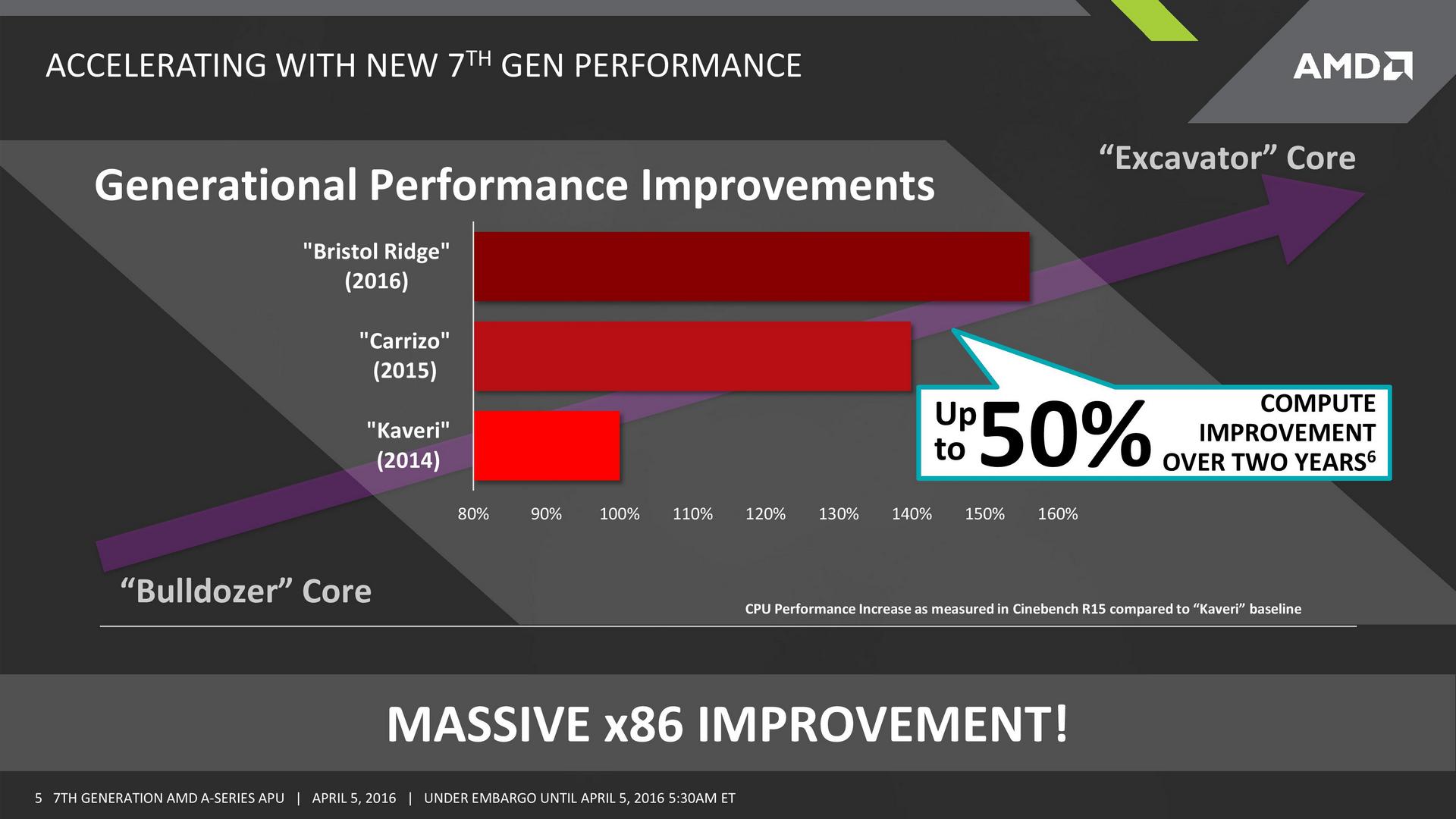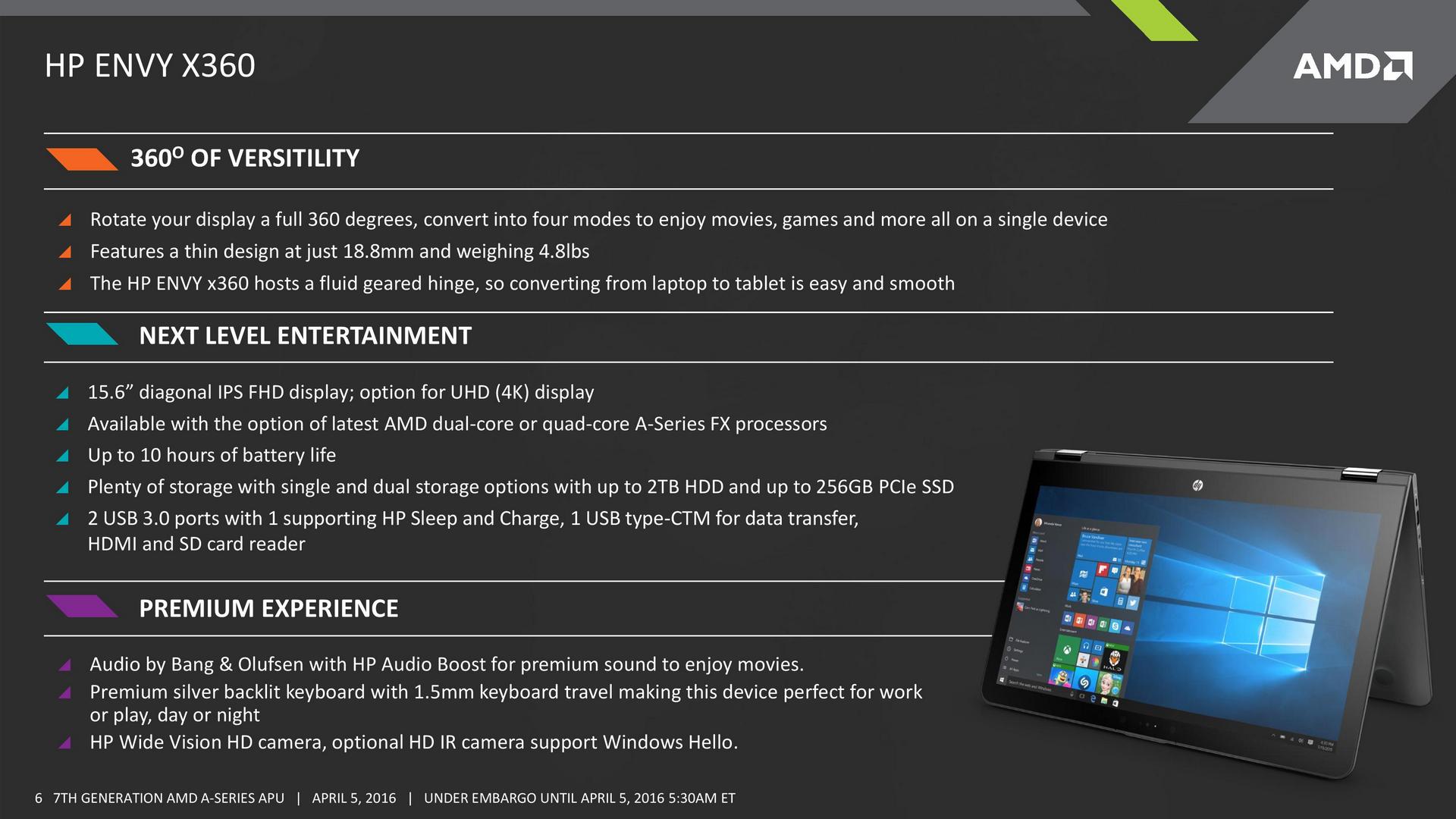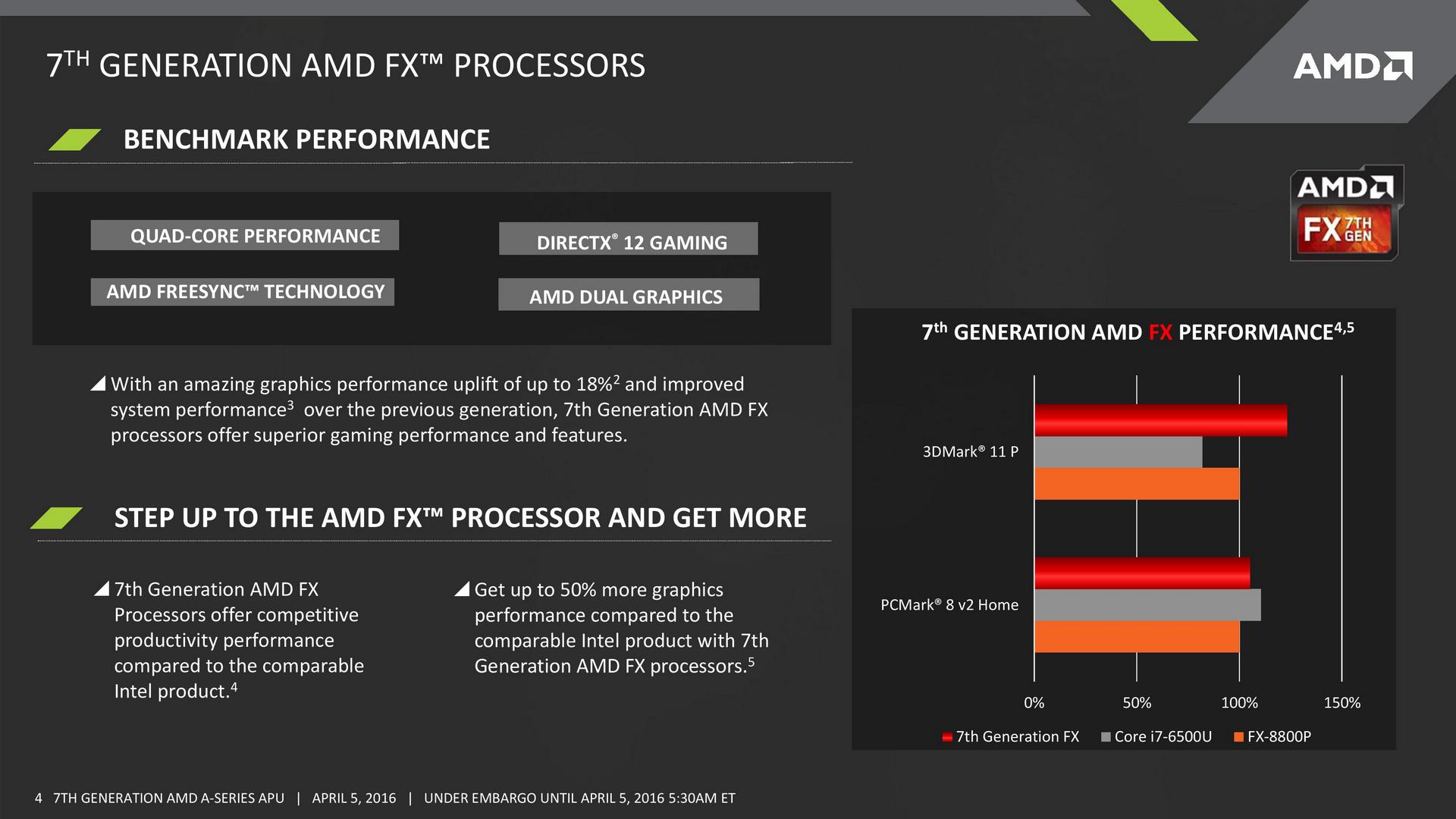AMD Pre-Announces Bristol Ridge in Notebooks: The 7th Generation APU
by Ian Cutress on April 5, 2016 6:30 AM EST-page-002_678x452.jpg)
For anyone tracking AMD’s family of Accelerated Processing Units (APUs), the last generation Carrizo was launched back in the middle of 2015. This was based on the fourth iteration of the Bulldozer module design (the cores are codenamed Excavator), focused entirely on notebooks at a 15-35W power window. Today marks the pre-announcement of the 2016 line, Bristol Ridge, for notebooks.
The main difference between Bristol Ridge and Carrizo is the implementation of a DDR4 memory controller, along with minor microarchitecture manufacturing tweaks. We’ve already seen Carrizo/Excavator under DDR4 in the embedded space, and AMD is claiming that this latest generation of Bristol Ridge offers up to at 50% CPU improvement over Kaveri, launched in 2014, and Bristol Ridge is some 10% over Carrizo due to the new memory support.
Despite AMD quoting a 50% gain in Cinebench compared to Kaveri, AMD’s strengths in the notebook line are partly due to the integrated graphics, which historically gets a boost from faster memory. Although this depends on the underlying design by the OEM, as we detailed in our Carrizo OEM overview that pointed the finger at base single channel memory designs being the norm at retail, rather than dual channel.
Today is a pre-announcement, which means that details are very thin. The reason this is not a full launch lies in one of AMD’s OEM partners, HP, announcing a new notebook at GTC this week based on AMD’s Bristol Ridge designs. HP is AMD’s biggest partner in notebooks, and is launching the HP Envy x360 15-inch variant using a Bristol Ridge part under the AMD FX naming scheme.
We’ll go deeper into the Envy x360 announcements in a separate news post. But this pre-announcement means that AMD are happy to talk about high level details such as 3DMark performance compared to Carrizo and Intel, FreeSync sypport, Dual Graphics, DirectX 12 and so on, but we will have to wait until Computex 2016 when we’ll get the full breakdown of the APU advancements, SKU names, clock speeds and where these APUs will be implemented.
As mentioned in previous news posts, AMD on the desktop has confirmed that Bristol Ridge and the upcoming Summit Ridge APUs featuring a brand new microarchitecture design will share a platform. We could extrapolate (as others have done so) to suggest that this notebook platform will also be the one supporting Summit Ridge on notebooks when it is released, however AMD has not officially confirmed this for this pre-announcement. We will have to wait for Computex for more details.
Further Reading:
AMD Launches Excavator APUs for Embedded with DDR4 Support
Who Controls the User Experience? AMD’s Carrizo Thoroughly Tested
AMD Launches Carrizo: The Laptop Leap of Efficiency and Architecture Updates





-page-001_thumb.jpg)
-page-002_thumb.jpg)
-page-003_thumb.jpg)
-page-007_thumb.jpg)
-page-008_thumb.jpg)
-page-009_thumb.jpg)








38 Comments
View All Comments
yankeeDDL - Tuesday, April 5, 2016 - link
I own one laptop with Kaveri and one with Carrizo and honestly, I think they are tremendous values for the money. I don't think that Bristol Ridge will be worth waiting for, but if it helps having a few more options with AMD inside, I think it'll be good for everybody: more competition always helps.Personally, I find these a good choice for "multi purpose" home PC/laptops. Casual gaming is solid and the rest of the performance is good. Yes, it falls short of Intel's in terms of sheer CPU speed and power efficiency, but you'd be hard pressed to see a difference unless you do heavy encoding. But you get the benefit of a good GPU on AMD platform and, usually, lower prices.
beginner99 - Tuesday, April 5, 2016 - link
Problem is most if these system ship with single-channel memory and not the top-line APU. The later means the GPU mostly isn't that much better anymore than intels. If you actually manage to find the top-sku with dual.channel memory, price wise your in intel i5 + nv dGPU area. And this combo just beats an APU by a huge margin. Battery life might suffer a bit but doesn't really matter for "home laptop". Mobile dGPUs still are just a lot faster than iGPU especially under throttling scenarios and in these AMD APUs can actually also become CPU limited.AMD is just too slow. If you can combine the APU with a dGPU and the dGPU is only used for 3D heavy apps, then it gets more useful (turn CrossFire on/off). But as it seems AMD just betting on game developers to implement heterogeneous multi-gpu in dx12 correctly.
azazel1024 - Tuesday, April 5, 2016 - link
I think some of it is the single channel issue with AMD laptops, but I think the other is, in the same power space, Intel has generally caught up to AMD by in large in terms of performance, if not a little better. Intel's Skylake GPUs in the 15w space and especially in the 4.5w space are far and away faster than the AMD offerings, especially when you factor in the single versus dual channel memory issues. In the 35/45w space, it is often the case to, especially with Intel's eDRAM offerings vs what AMD has on tap.Go back a generation or two and that wouldn't necessarily be the case, but Intel has narrowed the GPU performance gap each generation (and frankly, even 2-3 generations ago, AMD's 17w and below offerings are horribly anemic for CPU and GPU, the 35-45w AMD offerings were below Intel in CPU, but generally had better GPU because there weren't nearly the same power constraint issues).
TheinsanegamerN - Tuesday, April 26, 2016 - link
I'm sure AMD being stuck on 28nm has not helped things much.EagleEye5 - Tuesday, April 5, 2016 - link
For what it's worth, I have an A10-7400p kaveri laptop and the performance is really great, much better than AMD is showing in their graphs. For example, I get a score of 1900 in 3d mark 11 (amd's graphs show ~1400), and for cinebench 15 I get 201, theirs show 145 or so.The laptop came with only single channel ram, but for $35, I added a second stick and it doubled my performance. Also, I disabled turbo core, which also disables cpu and gpu throttling, improving performance by another 20-30% in most tests.
Sure, manufacturers including only single channel ram is a problem, but it's easy to fix by adding a second stick. However, while it's highly likely to work for kaveri, some carrizo motherboards don't physically have the second channel on the motherboard which is a problem.
EagleEye5 - Tuesday, April 5, 2016 - link
It's also worth noting that my laptop was only $400, probably one of the best deals out there for cost/perf ratioAlexvrb - Wednesday, April 6, 2016 - link
I expect the single-channel-only mainboard trend will continue. I hope I'm wrong, but as you said some shared Puma/Carrizo boards did not support a second memory channel regardless of the APU used or number of physical slots.I would be very surprised to see disabling turbo core benefiting anything but benchmarks. In typical use, it improves overall user experience with short bursts of high speeds. Plus if you're not running a GPU load, it should give more headroom for higher CPU clocks. Then again that's a higher-TDP model and base clocks are already fairly high. Disabling it on the 20W or below models (or configurable TDP models that OEMs typically configure around 15W) would probably have a larger (and mostly negative) impact. Either way I hope Bristol Ridge and beyond continues to refine turbo core with improved granularity.
EagleEye5 - Wednesday, April 6, 2016 - link
Yeah the single channel motherboards are a real issue. One of the main reasons I chose a kaveri laptop over carrizo is to have that guaranteed dual channel support.As for the turbo core performance, as you said it's good for burst tasks such as loading up games/programs or zipping/unzipping files, etc. However, it is terrible for sustained load in games. The stock speed of the a10-7400p is 2.5ghz and with turbo core on it turbos up to 3.0-3.5ghz for burst tasks. However, in games it starts at 3.5ghz, then throttles all the way down to 1.4ghz after playing for a few minutes. This is with a 35w tdp part too. For example, in tomb raider (not rise of), just standing still in a particular scene can start with 50-55 fps, then I can watch the frame rate gradually degrade until it hits 25 or so. With turbo core disabled, it hovers at a constant 45 fps without fluctuating; the clock speed stays at a constant 2.5ghz. The igpu clock stays at a constant 655mhz as well, it would throttle down to 400-500mhz with turbo core enabled. Disabling turbo core has clear real world impact.
Disabling turbo core also seems to raise the tdp cap, but nothing too crazy. With turbo core enabled, the temperature caps at about 63C, whereas disabling turbo core raises the temp to 73 or so, which really isn't that bad for the significant performance boost.
yankeeDDL - Wednesday, April 6, 2016 - link
Actually, most laptops use K10 APUs, which are at the top of their line.I have a Toshiba with the A10 7800P which costed me around 450usd. Granted is not high-end, but it handles games with ease (for an iGPU): better than anything Intel has to offer.
And the CPU gap is not noticeable on everyday tasks: it is nearly impossible to max out the CPU unless you are doing some specific coding/compression.
medi03 - Thursday, April 7, 2016 - link
Except that the only perf demanding things most people can throw at their notebooks are actually games.For most other uses your CPU is sitting there idle and whether it is 3% load at idle, or 5%, doesn't change a thing.
Going with discrete GPU results in major price increase.